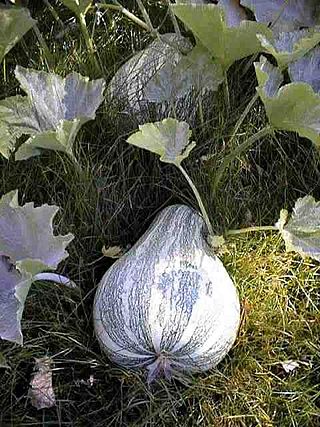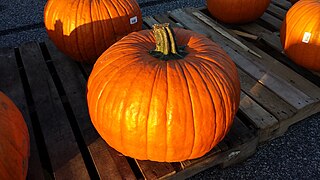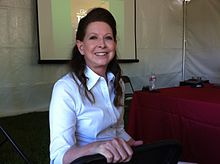
The zucchini, courgette or baby marrow is a summer squash, a vining herbaceous plant whose fruit are harvested when their immature seeds and epicarp (rind) are still soft and edible. It is closely related, but not identical, to the marrow; its fruit may be called marrow when mature.

An heirloom plant, heirloom variety, heritage fruit, or heirloom vegetable is an old cultivar of a plant used for food that is grown and maintained by gardeners and farmers, particularly in isolated communities of the Western world. These were commonly grown during earlier periods in human history, but are not used in modern large-scale agriculture.
Kent Whealy was an American activist, journalist and philanthropist who co-founded Seed Savers Exchange and promoted organic agriculture and the saving of heirloom seeds. Raised in Wellington, Kansas he was inspired by the works of agricultural geneticists Jack Harlan and H.Garrison Wilkes to use his training in communications to promote the protection of genetic diversity in agriculture.
Dan Jason is a Canadian active in food politics, as an opponent of genetically modified foods and proponent of heirloom plants and seedbanks. He is a writer, lecturer, and runs a business providing heirloom seeds.
Seed Savers Exchange, or SSE, is a non-profit organization based near Decorah, Iowa, that preserves heirloom plant varieties through regeneration, distribution and seed exchange. It is one of the largest nongovernmental seedbanks in the United States. The mission of SSE is to preserve the world’s diverse but endangered garden heritage for future generations by building a network of people committed to collecting, conserving, and sharing heirloom seeds and plants, and educating people about the value of genetic and cultural diversity. Since 1975, Seed Savers has produced an annual yearbook of members’ seed offerings, as well as multiple editions of The Garden Seed Inventory, and The Fruit, Nut and Berry Inventory. SSE also publishes Seed to Seed: Seed Saving and Growing Techniques for Vegetable Gardeners. The nonprofit has sold seeds to about 600 retail stores in the United States and Canada.
Southern Exposure Seed Exchange (SESE) is a cooperatively-owned seed company based out of Mineral, Virginia. SESE is a source for heirloom seeds and other open-pollinated (non-hybrid) seeds with an emphasis on vegetables, flowers, and herbs that grow well in the Mid-Atlantic region. SESE also supports seed saving and traditional seed breeding through their product line, through lectures and workshops, and by working with over 50 small seed-growing farmers in the Mid-Atlantic and other parts of the United States. SESE publishes an intermittent email newsletter and blog for gardeners, as well as the Southern Exposure Seed Exchange Catalog and Garden Guide.

Olericulture is the science of vegetable growing, dealing with the culture of non-woody (herbaceous) plants for food.

Morgan Carrington "Cary" Fowler Jr. is an American agriculturalist and the former executive director of the Crop Trust, currently serving as U.S. Special Envoy for Global Food Security.

Cucurbita maxima, one of at least five species of cultivated squash, is one of the most diverse domesticated species. This species originated in South America from the wild subspecies Cucurbita maxima subsp. andreana over 4,000 years ago. Cucurbita maxima, known for modern varieties as Hubbard, Delicious, Marblehead, Boston Marrow, and Turks Turban, originated in northern Argentina near the Andes or in certain Andean valleys. Secondary centers of diversity include India, Bangladesh, Myanmar, and the southern Appalachians.

A pumpkin is a cultivated winter squash in the genus Cucurbita. The term is most commonly applied to round, orange-colored squash varieties, though it does not possess a scientific definition and may be used in reference to many different squashes of varied appearance.

Cucurbita argyrosperma, also called the cushaw squash and silver-seed gourd, is a species of winter squash originally from the south of Mexico. This annual herbaceous plant is cultivated in the Americas for its nutritional value: its flowers, shoots, and fruits are all harvested, but it is cultivated most of all for its seeds, which are used for sauces. It was formerly known as Cucurbita mixta.
The Open Source Seed Initiative (OSSI) is an organization that developed and maintains a mechanism through which plant breeders can designate the new crop varieties they have bred as open source. This mechanism is advanced as an alternative to patent-protected seeds sold by large agriculture companies such as Monsanto or DuPont. OSSI is a U.S. based not-for-profit 501(c)(3) organization focusing on establishing a protected commons of open source varieties and on educational and outreach activities associated with the development of this open source seed commons and on seed rights and issues related to the control of seed.
Siberian tomato is a type of the common tomato plant. It is referred to as "Siberian" because it can set fruit at 38 °F (3 °C), although it is not particularly frost hardy, despite its name.

Connecticut field pumpkins are a type of pumpkin first attested in the 16th century. They are one of the oldest varieties of pumpkin in existence and are known as an heirloom plant. One of the most popular Halloween pumpkins, Connecticut field pumpkins are commonly used for autumn decorations and jack-o'-lanterns; a strain of Connecticut field pumpkins have been described as "the original commercial jack-o'-lantern pumpkin". Due to the variety's appearance and growth process, it is considered to be well-suited for ornamental use. It also has culinary uses, particularly in canning, and was used for medicinal purposes by Native Americans in the United States prior to European contact.
Will Bonsall is an American author, seed saver and veganic farmer who lives in Maine. He is a regular speaker about seed saving, organic farming and veganic farming.

Elwyn Marshall Meader was an American botanist and plant scientist. Over the course of his career, Meader developed over 50 new strains of plum, peach, squash, rutabaga, sweet corn, melon, watermelon, salad bean, pod bean, pepper, pumpkin, nectarine, bush cherry, kiwi fruit, persimmon, cranberry, raspberry, and blueberry. He developed the Miss Kim Lilac from seeds of a wild lilac bush he found in the mountains of Korea and decided to name it after "all the Miss Kims in Korea".

Albert Franklin Yeager was an American horticulturalist. From his work developing hardy vegetables and fruits at the North Dakota Agricultural College (NDAC) and the North Dakota Agricultural Experiment Station (NDAES), he was known as the "plant wizard of the north" and the "Luther Burbank of North Dakota."
Frank H. Morton is an organic farmer, gardener, plant breeder and seedsman known for creating dozens of varieties of lettuce.

Ira Wallace is a gardener, teacher and author. She manages Southern Exposure Seed Exchange, a cooperatively-owned seed company.











